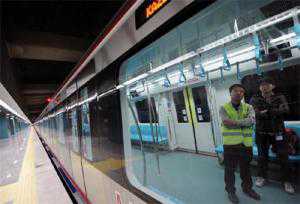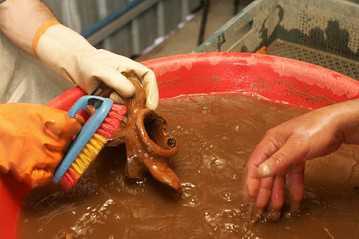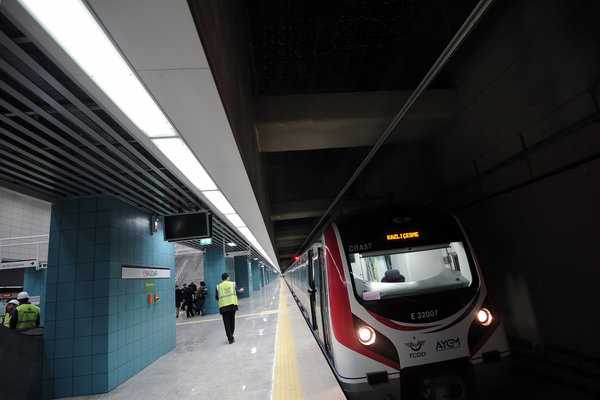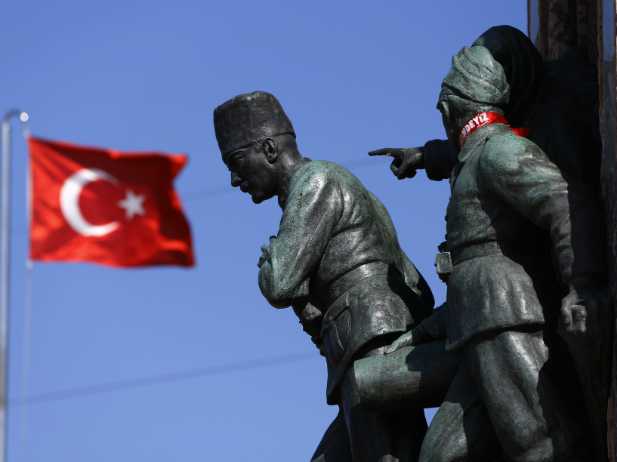Ground broke on the tunnel in 2004, but various challenges—the discovery of the remains of a Byzantine port, concerns about earthquakes—delayed its construction. The last stages were rushed so that the grand opening would fall on Republic Day. Across Istanbul, banners announcing the tunnel were almost as ubiquitous as Turkish flags, and much more grandiose. One billboard in Üsküdar, featuring a grainy closeup of Erdoğan test-driving a train through the tunnel, with President Abdullah Gül and a few international heads of state standing behind him, read, “The Leaders of the Century, the Project of the Century: The Marmaray Opens.”
On Tuesday morning, while riot police arrived by bus at Istanbul’s Taksim Square—where protests in May, intended to halt the redevelopment of Gezi Park, sparked months of anti-government agitations across the country—Erdoğan and Gül were in Ankara, visiting the hilltop tomb of Mustafa Kemal Atatürk, who founded the Turkish Republic nine decades ago. By midday, the scene at Üsküdar was a zoo. Crowds pushed through metal detectors, trying to claim space near the stage where Erdoğan, Gül, and visiting dignitaries from Japan (a partner in the project), Somalia, and Romania were scheduled to speak. Attendees were given white baseball caps festooned with a Marmaray logo, which looks like the double barrel of a shotgun. One elderly man, to show his excitement, stacked two hats on his head.
Behind the crowd, giant banners of Atatürk, Gül, and Erdoğan waved in the breeze; beyond that, more people gathered on the steep Üsküdar hills. Boats anchored just off the coast sprayed plumes of water into the air and sounded their horns when the Prime Minister took the stage. “Whether they like us or not, whether they vote for us or not, they will be proud of this project,” Erdoğan said to the cheering crowd. “We have given the Republic a much stronger structure by decorating it with brotherhood, unity, solidarity, justice, equality, and democracy.”
Urban development, including record-breaking mega-projects like Marmaray, has been a consistent focus throughout Erdoğan’s political career, first as the mayor of Istanbul and then, for the past decade, as Prime Minister. Migration to Istanbul from the rest of Turkey, and the resulting construction boom, has transformed the city over the past two decades. Erdoğan uses development statistics as evidence of his party’s success. “We have added seventeen thousand kilometres of road in eleven years,” Erdoğan said on Tuesday. “When we came into power, there were twenty-six airports, and now there are more than fifty.”
But these development projects were at the heart of the protest movement that grew in Gezi Park, and although Gezi itself is safe for now Erdoğan shows no sign of stopping. He has plans to build the world’s largest airport on the European side of Istanbul, as well as a third bridge over the Bosporus and another tunnel, for cars, beneath it. Critics say that the construction companies are overfed and too powerful, steering rather than accommodating development. Akif Burak Atlar, the secretary general of the Istanbul branch of the Chamber of Urban Planners, sees value in the Marmaray project—“Istanbul has a huge traffic problem, especially during rush hour,” he said—but not in Erdoğan’s larger vision. “The third bridge is not a necessary transportation project,” Atlar, who is also a member of Taksim Solidarity, the group of activists at the center of Gezi, said. “It’s more of a real-estate project.”
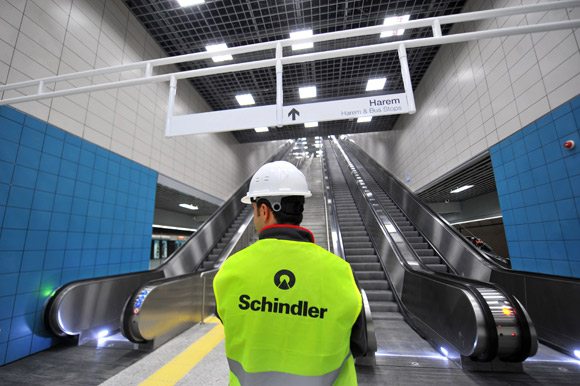
These urbanization projects have deep meaning in Turkey, to critics and supporters alike; it’s no coincidence that the opening of Marmaray took place on an important anniversary of the Republic itself. Erdoğan sees the projects as evidence that he is transforming Istanbul into a world capital. Opponents see them as another sign of his authoritarian tendencies. The plans for Gezi were a prime example. “We are living these shitty lives with two salaries,” said Umud Dalgıç, a sociologist and project coördinator at the Istanbul branch of the Heinrich Boll Foundation, “and now this little park we go to on the weekend” is going to be razed. He said, “There’s no innuendo. There’s a big shopping mall being built there. It’s very literal.”
Erdoğan’s crackdown on the protests, which left hundreds injured and six dead, was seen as indisputable evidence of his authoritarianism. Along with the brutality came a measure of foolishness—miscalculations and a failure or unwillingness to understand the desires of the population that was also visible at Tuesday’s festivities. In a city of sixteen million people, the Marmaray project provides a much-needed addition to Istanbul’s public-transportation system, and the opening ceremony was a missed opportunity for the Prime Minister to advertise its benefits; instead, he lumped it in with other, more controversial projects, and played only to his base. In doing so, he reminded his opposition of why they fought against him in Gezi Park.
“None of these projects are executed in a transparent way,” Dalgıç said. “The public doesn’t get any information about who the contractors are or what the schedule is.” He suspects that the rush on the Marmaray project has to do with the local and presidential elections, both of which are coming up in 2014. “Zillions of these projects will be announced before the elections,” he said, “and they will say that all of them will change your life.”
Critics worry about the safety of the tunnel, which runs parallel to a major fault line, and the lack of transparency coupled with a cynicism about Erdoğan’s priorities turns worry into paranoia. “We are very much afraid that it was sped up because the Prime Minister wanted it opened on Republic Day,” Cihan Baysal, a member of the Urban Movements group and a leading housing-rights activist, said. “Experts say that signals aren’t working, that there aren’t enough checks and controls.” When a Marmaray train stalled because of an electrical failure the day after the opening—passengers had to evacuate through the tunnel on foot—it seemed to confirm Baysal’s fears. “I am very curious about the tunnel,” she told me, “but I’m afraid to use it. I don’t trust the politicians.”
If Erdoğan felt at all deflated by these protests against his mega-projects, the ceremony in Üsküdar may have lifted his spirits. The Romanian Prime Minister, Victor Ponta, called the tunnel an “unbelievable achievement” and lavished praise on his Turkish counterpart. “Great projects can only be done by great people and great political leaders,” he said. “Erdoğan, you will begin to be again the center of these two worlds that you connect.”
Shinzo Abe, the Prime Minister of Japan, joked about having competed with Turkey for the 2020 Olympic Games (Tokyo won) and said how pleased he was that Erdoğan embraced him after that announcement. “We know you have difficulties right now,” he said. “Hopefully you will be prosperous forever.”
Between speeches, a man in the crowd shouted, “Thank God that you, the grandson of the ancestors, were destined to restore their legacy!” (The “legacy” he had in mind was that of the Ottoman sultans.)
After the ceremony, I boarded a ferry to Taksim Square. Demonstrations on Republic Day tend to veer away from the mainstream opposition and toward the ultra-nationalistic, but in the wake of Gezi the city was braced for anything. Nationalists, after all, had been present in the park as well. I wondered if the announcement of such a major development project would inspire some protests, considering the concerns of the activists I interviewed. At least a dozen buses full of riot police lined the square, but the officers were huddled near them, giving directions to tourists. Others leaned on their shields, ready to block side streets at a moment’s notice but looking like they knew that moment was unlikely to come. It never did.
Jenna Krajeski received support for the reporting in this post from the Pulitzer Center on Crisis Reporting.
Top photograph: Oktay Cilesiz/Anadolu Agency/Getty. Middle photograph: Ozan Kose/AFP/Getty
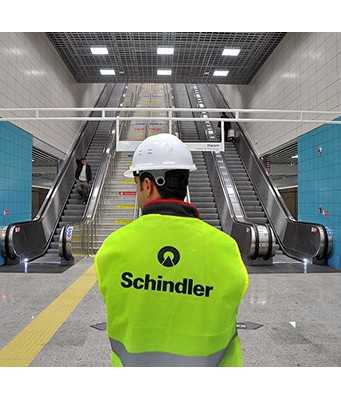 Schindler’s contribution of 10 elevators and 63 escalators to the Marmaray Project included the challenge of fitting 4 escalators that are among the longest in Europe at 65 meters in length.
Schindler’s contribution of 10 elevators and 63 escalators to the Marmaray Project included the challenge of fitting 4 escalators that are among the longest in Europe at 65 meters in length.

